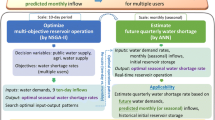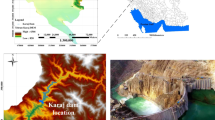Abstract
In this study, an algorithm combining a multi-objective genetic algorithm (GA)-based optimization model and a water quality simulation model is developed for determining a trade-off curve between objectives related to the allocated water quantity and quality. To reduce the run-time of the GA-based optimization model, the main problem is decomposed to long-term and annual optimization models. The reliability of water supply is considered to be the objective function in the long-term stochastic optimization model, but the objective functions of the annual models are related to both the allocated water quantity and quality. The operating policies obtained using this long-term model provide the time series of the optimum reservoir water storages at the beginning and the end of each water year. In the next step, these optimal reservoir storage values are considered as constraints for water storage in the annual reservoir operation optimization models. The ɛ-constraint method is then used to develop a trade-off curve between the reliability of water supply and the average allocated water quality. The Young conflict resolution theory, which incorporates the existing conflicts among decision-makers and stakeholders, is used for selecting the best solution on the trade-off curve. The monthly reservoir operating rules are then calculated using an Adaptive Neuro-Fuzzy Inference System, which is trained using the optimal operating polices. The proposed model is applied to the 15-Khordad Reservoir in the central part of Iran. The results show that this simplified procedure does not reduce the accuracy of the reservoir operating policies and it can effectively reduce the computational burden of the previously developed models.
Similar content being viewed by others
References
Abrishamchi, A., Afshar, A., & Kerachian, R. (2003). Spillway capacity optimization under hydrologic uncertainties. Iranian Journal of Science and Technology, 27(B1), 111–122.
Chaves, P., & Kojiri, T. (2007). Deriving reservoir operational strategies considering water quantity and quality objectives by stochastic fuzzy neural networks. Advances in Water Resources, 30(5), 1329–1341.
Chaves, P., Tsukatani, T., & Kojiri, T. (2004). Operation of storage reservoir for water quality by using optimization and artificial intelligence techniques. Mathematics and Computers in Simulations, 67, 419–432.
Dandy, G., & Crawley, P. (1992). Optimum operation of a multiple reservoir system including salinity effects. Water Resources Research, 28(4), 979–990.
Fontane, D., Labadie, J. W., & Loftis, B. (1981). Optimal control of reservoir discharge quality through selective withdrawal. Water Resources Research, 17(6), 1594–1604.
Ganji, A., Khalili, D., & Karamouz, M. (2007). Development of stochastic dynamic nash game model for reservoir operation. I: The symmetric stochastic model with perfect information. Advances in Water Resources, 30, 528–542.
Ganji, A., Khalili, D., & Karamouz, M. (2006). Development of stochastic dynamic nash game model for reservoir operation. II: The value of players’ information availability and cooperative behaviors. Advances in Water Resources, 30, 157–168.
Hayes, D. F., Labadie, J. W., Sanders, T. G., & Brown, J. K. (1998). Enhancing water quality in hydropower system operation. Water Resources Research, 34(3), 471–483.
Kaplan E. (1974). Reservoir optimization for water quality control, Ph.D. dissertation, Univ. of Pennsylvania, Philadelphia.
Karamouz, M., Zahraie, B., & Kerachian, R. (2003). Development of a master plan for water pollution control using MCDM techniques: A case study. Water International,IWRA, 28(4), 478–490.
Kerachian, R., & Karamouz, M. (2005). Waste-load allocation model for seasonal river water quality management: application of sequential dynamic genetic algorithms. Scientia Iranica, 12(2), 117–130.
Kerachian, R. (2004). Water quality management in river-reservoir systems, Ph.D. dissertation, Department of Civil and Environmental Engineering, Amirkabir University (Tehran Polytechnic), Teheran, Iran.
Kerachian, R., & Karamouz, M. (2006). Optimal reservoir operation considering the water quality issues: a stochastic conflict resolution approach. Water Resources Research. AGU, W 12401, DOI 10.1029/2005WR004575, 42, 1-17.
Kerachian, R., & Karamouz, M. (2007). A stochastic conflict resolution model for water quality management in reservoir-river systems. Advances in Water Resources. DOI 10.1016/j.advwaters.2006.07.005, 30, 866-882.
Loaiciga, H. A. (2004). Analytic game-theoretic approach to groundwater extraction. Journal of Hydrology, 297(1–4), 22–33.
Loftis, B., Labadie, J. W., & Fontane, D. (1985). Optimal operation of a system of lakes for quality and quantity, Proceedings of Specially Conference on Computer Applications in Water Resources, Buffalo, N.Y.
Nandalal, K. D. W., & Bogardi, J. J. (1995). Reservoir management for improving river water quality. Proc. of Water Resources Management Under Drought or Water Storage Conditions, Rotterdam, 257–264.
Napel, S. (2002). Bilateral bargaining: Theory and applications. Berlin: Springer-Verlag.
Richards, A., & Singh, N. (1996). Two level negotiations in Bargaining over water, Proceedings of the International Game Theory Conference, Bangalore, India, 1–23.
Shirangi, E., & Kerachian, R. (2007). A simplified model for optimal reservoir operation considering the water quality issues, Proceedings of CEMEPE/SECOTOX Conference, June 24–28, Skiathos island, Greece.
U.S. Army Corps of Engineers (USACE) (1986). HEC-5, simulation of flood control and conservation systems, appendix on water quality analysis, report, Hydrol. Eng. Cent., Davis, Calif.
Young, H. P. (1993). An evolutionary model of bargaining. Journal of Economic Theory, 59, 145–168.
Author information
Authors and Affiliations
Corresponding author
Rights and permissions
About this article
Cite this article
Shirangi, E., Kerachian, R. & Bajestan, M.S. A simplified model for reservoir operation considering the water quality issues: Application of the Young conflict resolution theory. Environ Monit Assess 146, 77–89 (2008). https://doi.org/10.1007/s10661-007-0061-0
Received:
Accepted:
Published:
Issue Date:
DOI: https://doi.org/10.1007/s10661-007-0061-0




